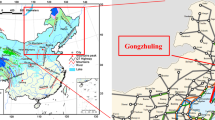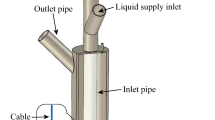Abstract
Due to the ignorance of the influence of frozen soil during the design period, the frost damage of subgrade in Datong-Junggar Railway was serious. The improvement scheme of frost damage was researched. However, the research based on the existing project was few, and previous improvement schemes could have an impact on the normal operation of railway system. Datong-Junggar Railway has undertaken the important task of transporting coal resources for China since its normal operation. To ensure normal operation of existing railway, the heating hole scheme was investigated by finite element simulations. The embedding spacing, the heating hole temperature and the embedding depth were analyzed. Based on the simulated results and on-site conditions, the design scheme of the heating hole (embedding spacing: 1.0 m, the heating hole temperature: 30°C and embedding depth: 70 cm) was proposed. Finally, the on-site monitoring in Qianshimen was taken to verify the feasibility of the heating hole scheme. Under the continuous energizing condition, the ground temperature remained basically stable even though the temperature had dropped to −7°C. The research results could enrich the design schemes for frost damage in cold regions from the aspect of ground temperature control.
Similar content being viewed by others
Abbreviations
- c :
-
Volumetric heat capacity of the subgrade soil (kJ m−3K−1)
- {F}:
-
A column vector of temperature load related to boundary conditions
- {K}:
-
A temperature stiffness matrix
- {M}:
-
A non-steady state variable temperature matrix
- N i, Nj :
-
Shape functions of the calculation unit
- q v :
-
The intensity of heat source
- T :
-
The temperature (°C) in the subgrade
- T α :
-
Ambient temperature (°C)
- {T}:
-
A column vector of unknown temperature
- α :
-
The convective heat transfer coefficient (W m−2K−1)
- λ :
-
The thermal conductivity of the subgrade soil (W m−1K−1)
- ρ :
-
The density of the subgrade soil (kg m−3)
- Ω :
-
The spatial domain of the accumulated temperature field
References
Andersland OB, Ladanyi B (1994) An introduction to frozen ground engineering. Chapman and Hall, New York, NY, USA, DOI: https://doi.org/10.1007/978-1-4757-2290-1
Andersland OB, Ladanyi B (2004) Frozen ground engineering. American Society of Civil Engineering, Reston, VA, USA
Asfour S, Bernardin F, Toussaint E, Piau JM (2016) Hydrothermal modeling of porous pavement for its surface de-freezing. Applied Thermal Engineering 107:493–500, DOI: https://doi.org/10.1016/j.applthermaleng.2016.06.138
Chen XB, Wang YQ (1991) A new model of frost heave prediction for clayey soils. Cold Regions Science and Technology 19(2):213–214, DOI: https://doi.org/10.1016/0165-232X(91)90010-E
Everett DH (1961) The thermo dynamics of frost damage to porous solids. Transactions of the Faraday Society 57:1541–1551, DOI: https://doi.org/10.1039/tf9615701541
Feng Q, Jiang BS, Zhang Q, Wang G (2016) Reliability research on the 5-cm-thick insulation layer used in the Yuximolegai tunnel based on a physical model test. Cold Regions Science and Technology 124:54–56, DOI: https://doi.org/10.1016/j.coldregions.2016.01.001
Fourier J (1822) The analytical theory of heat. Cambridge University Press, London, UK
Harlan RL (1973) Analysis of coupled heat-fluid transport in partially frozen soil. Water Resources Research 9:1314–1323, DOI: https://doi.org/10.1029/WR009i005p01314
Hermansson A, Guthrie WS (2005) Frost heave and water uptake rates in silty soil subject to variable water table height during freezing. Cold Regions Science and Technology 43(3):128–139, DOI: https://doi.org/10.1016/j.coldregions.2005.03.003
Islam MR, Tarefder RA (2016) Effects of large freeze-thaw cycles on stiffness and tensile strength of asphalt concrete. Journal of Cold Regions Engineering 30(1):1–9, DOI: https://doi.org/10.1061/(ASCE)CR.1943-5495.0000094
Johanse O (1975) Thermal conductivity of soils. PhD Thesis, Trondheim, Norway
Kay BD, Groenevelt PH (1974) On the interaction of water and heat transport in frozen and unfrozen soils: I basic theory; The vapor phase. Soil Science 38:395–400, DOI: https://doi.org/10.2136/sssaj1974.03615995003800030011x
Konrad JM, Duquennoi C (1993) A model for water transport and ice lensing in freezing soils. Water Resources Research 29:3109–3124, DOI: https://doi.org/10.1029/93WR00773
Lai JX, Qiu JL, Fan HB, Chen J, Xie YL (2016) Freeze-proof method and test verification of a cold region tunnel employing electric heat tracing. Tunnelling and Underground Space Technology 60:56–65, DOI: https://doi.org/10.1016/j.tust.2016.08.002
Lai Y, Xu X, Yu W, Qi J (2014) An experimental investigation of the mechanical behavior and a hyperplastic constitutive model of frozen loess. International Journal of Engineering Science 84:29–53, DOI: https://doi.org/10.1016/j.ijengsci.2014.06.011
Li SY, Zhang MY, Tian YB, Pei WS, Zhong H (2015) Experimental and numerical investigations on frost damage mechanism of a canal in cold regions. Cold Regions Science and Technology 116:1–11, DOI: https://doi.org/10.1016/j.coldregions.2015.03.013
Li H, Zhang QQ, Xiao HG (2013) Self-deicing road system with a CNFP high-efficiency thermal source and MWCNT/cement-based high-thermal conductive composites. Cold Regions Science and Technology 86:22–35, DOI: https://doi.org/10.1016/j.coldregions.2012.10.007
Liu H, Niu FJ, Niu YH, Lin Z, Lu J, Luo J (2012) Experimental and numerical investigation on temperature characteristics of high-speed railway’s subgrade in seasonal frozen regions. Cold Regions Science and Technology 81:55–64, DOI: https://doi.org/10.1016/j.coldregions.2012.04.004
Liu H, Niu FJ, Niu YH, Xu J, Wang T (2016) Effect of structures and sunny-shady slopes on thermal characteristics of subgrade along the Harbin-Dalian passenger dedicated line in Northeast China. Cold Regions Science and Technology 123:14–21, DOI: https://doi.org/10.1016/j.coldregions.2015.11.007
Liu H, Niu FJ, Niu YH, Yang X (2014) Study on thermal regime of roadbed-culvert transition section along a high speed railway in seasonally frozen regions. Cold Regions Science and Technology 106:216–231, DOI: https://doi.org/10.1016/j.coldregions.2014.07.008
Lu JF, Tan YP, Wang JH (2011) A phase field model for the freezing saturated porous medium. International Journal of Engineering Science 49:768–780, DOI: https://doi.org/10.1016/j.ijengsci.2011.03.014
Luo J, Tang L, Ling X, Geng L (2018) Experimental and analytical investigation on frost heave characteristics of an unsaturated moderately expansive clay. Cold Regions Science and Technology 155:343–353, DOI: https://doi.org/10.1016/j.coldregions.2018.08.023
Miller RD (2003) Redistribution of water in terrestrial soils at subfreezing temperatures: Are view of processes and their potential relevance to Mars. Journal of Geophysical Research 108, DOI: https://doi.org/10.1029/2002JE001873
Nield DA, Bejan A (1998) Convection in porous media, second edition. Springer·Verlag, New York, NY, USA
Niu FJ, Li AY, Luo J, Lin J, Lin Z, Yin G, Liu G, Zheng H, Liu H (2017) Soil moisture, ground temperatures, and deformation of a high-speed railway subgrade in Northeast China. Cold Regions Science and Technology 133:7–14, DOI: https://doi.org/10.1016/j.coldregions.2016.10.007
Nuijten ADW, Hoyland KV (2017) Modelling the thermal conductivity of a melting snow layer on a heated pavement. Cold Regions Science and Technology 140:20–29, DOI: https://doi.org/10.1016/j.coldregions.2017.04.008
O’Neill, Kevin, Miller RD (1985) Exploration of a rigid ice model of frost heave. Water Resources Research 21:281–296, DOI: https://doi.org/10.1029/WR021i003p00281
Pan P, Wu SP, Xiao Y, Liu G (2015) A review on hydronic asphalt pavement for energy harvesting and snow melting. Renewable and Sustainable Energy Reviews 48:624–634, DOI: https://doi.org/10.1016/j.rser.2015.04.029
Peppin S, Majumdar A, Style R, Sander G (2011) Frost heave in colloidal soils. SIAM Journal on Applied Mathematics 71:1717–1732
Rempel AW, Worster MG (2001) Particle trapping at an advancing solidification front with interfacial-curvature effects. Journal of Crystal Growth 223:420–432, DOI: https://doi.org/10.1016/S0022-0248(01)00595-4
Sheng DC, Zhang S, Yu Z, Zhang J (2013) Assessing frost susceptibility of soils using PC heave. Cold Regions Science and Technology 95(11):27–38, DOI: https://doi.org/10.1016/j.coldregions.2013.08.003
Tang L, Tian S, Ling XZ, Li G (2017) Effect of freeze-thaw cycles on the strength of base course materials used under China’s high-speed railway line. Journal of Cold Regions Engineering 31(4):1–9, DOI: https://doi.org/10.1061/(ASCE)CR.1943-5495.0000125
Wang TL, Yue ZR, Sun TC, Hua JC (2015) Influence of fines content on the anti-frost properties of coarse-grained soil. Sciences in Cold and Arid Regions 7(4):407–413
Zhang YZ, Du YL, Sun BC (2015) Temperature distribution analysis of high-speed railway roadbed in seasonally frozen regions based on empirical model. Cold Regions Science and Technology 114:61–72, DOI: https://doi.org/10.1016/j.coldregions.2015.02.010
Zhang Y, Johnson AE, White DJ (2016) Laboratory feeze-thaw assessment of cement, fly ash, and fiber stabilized pavement foundation materials. Cold Regions Science and Technology 122:50–57, DOI: https://doi.org/10.1016/j.coldregions.2015.11.005
Acknowledgments
The authors gratefully acknowledge the support of the Northwest Research Institute Co., Ltd of C. R. E. C., China Shenhua Energy Company Limited and the Southwest Jiaotong University, and under which this research project is performed. The field test is supported by Gui Yu, Yawei Ji and Xing Li from Northwest Research Institute Co., Ltd of C. R. E. C., and completed by Min Zhang and Ming Ming from Southwest Jiaotong University.
This work was supported by the Science & Technology Department of Sichuan Province [2021YFS0321, 2021YFS0323, 2020YFG0123] and Shenhua Group [SHGF-13-46].
Author information
Authors and Affiliations
Corresponding author
Rights and permissions
About this article
Cite this article
Zhang, J., He, Z. & Feng, J. Frost Damage Improvement for Railway Subgrade Based on Ground Temperature Control in Cold Regions. KSCE J Civ Eng 25, 2911–2921 (2021). https://doi.org/10.1007/s12205-021-2197-9
Received:
Revised:
Accepted:
Published:
Issue Date:
DOI: https://doi.org/10.1007/s12205-021-2197-9




